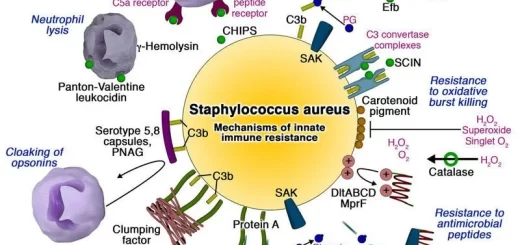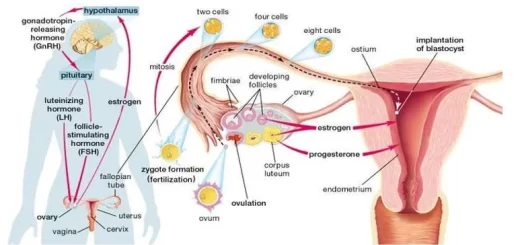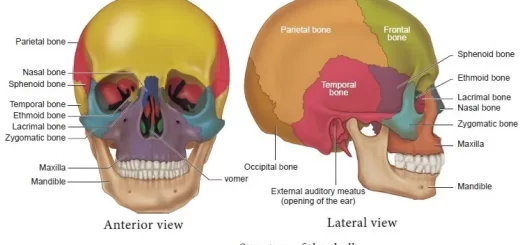Anatomy of the cardiovascular system, Thoracic cage function, structure and anatomy
The thoracic cage is known as the human rib cage, It is a bony and cartilaginous structure, It surrounds the thoracic cavity and supports the pectoral girdle, forming a core portion of the human skeleton, It has 24 ribs, the sternum (with the xiphoid process), costal cartilages, and the 12 thoracic vertebrae. It, along with the skin and associated fascia and muscles, makes up the thoracic wall and it provides attachments for the muscles of the neck, thorax, upper abdomen, and back.
Thoracic cage function
The thoracic cage serves to support the thorax, It has several functions, It can protect vital thoracic and abdominal internal organs from external forces, It can resist the negative internal pressures generated by the elastic recoil of the lungs and respiration-induced movements, It can offer attachment for and supporting the weight of the upper limbs, It can offer the anchoring attachment of many muscles that move and maintain the position of the upper limbs relative to the trunk.
Thoracic cage structure
The thoracic cage consists of the sternum, the ribs, and the thoracic vertebrae. It has a narrow inlet and a wide outlet.
Thoracic inlet (the upper opening of the thoracic cage)
Boundaries:
- Anterior …………………… The supra-sternal notch of the manubrium sterni.
- On each side ……………. First rib.
- Posterior ………………….. First thoracic vertebra.
Thoracic outlet
It is the lower opening of the thoracic cage.
Boundaries:
- Anterior …………………… Xiphoid process.
- On each side …………… Lower six costal cartilages + Last two ribs.
- Posterior …………………. Last thoracic vertebra.
Classification of the ribs according to their attachments to the sternum
There are twelve ribs on each side classified as:
- True ribs …… Upper seven ribs (their anterior end is attached to the sternum).
- False ribs ….. Lower five ribs (they are not attached anteriorly to the sternum).
The lower two ribs are called the floating ribs because they are free anteriorly.
Classification of ribs according to their structure
A: Typical …………. … 3rd – 9th ribs.
B: Atypical ……………. 1st, 2nd, 10th, 11th, and 12th ribs. (first two and last 3 ribs).
Typical rib
The typical rib is formed of (anterior end, posterior end, and a shaft), Anterior end: which is cup-shaped for articulation with its costal cartilage. Posterior end, formed by head, neck, and tubercle.
- The Head contains a small upper demifacet for articulation with the small lower demifacet on the side of the vertebra above it. it contains a large lower demifacet for articulation with the large upper demifacet on the side of the vertebra of the same number. Between both demifacets, there is the crest of the head.
- The neck is the flattened constriction next to the head.
- Tubercle, formed by articular part (medial part), which articulates with the circular facet on the tip of the transverse process of the vertebra of the same number. Non-articular part (lateral part), which is attached to the lateral costotransverse ligament.
C: two inches from the tubercle, there is the angle of the rib. It has two surfaces inner surface which is the concave and the outer surface. Its upper border is smooth and its lower border is sharp and has the costal groove which is related to the inter-costal vein, artery, and nerve (VAN) from above downwards.
Atypical ribs
1. First rib (general features): It has upper and lower surfaces. Its upper surface is rough containing many grooves and elevations. It carries a small tubercle close to the inner border (scalene tubercle) for insertion of the scalenus anterior muscle. This tubercle separates two grooves, the one posterior to it is for the subclavian artery, and that anterior is for a subclavian vein.
More posterior to the subclavian artery is the insertion of the scalenus medius muscle. The area anterior to the subclavian vein gives partial origin to the subclavius muscle. Its lower surface is smooth and lined by costal pleura. Its neck is related anteriorly from medial to lateral to:
- Stellate ganglion (The first thoracic ganglion fused with the inferior thoracic one).
- Superior intercostal artery.
- Ventral ramus of the 1st thoracic nerve.
2. Second rib: its shaft has no angel.
3. Tenth rib: It has a single articular facet on the head.
4 . Eleventh rib: It has a single articular facet on the head and no tubercle.
5 . Twelveth rib: It has:
- Single articular facet on the head.
- No tubercle.
- No neck.
- No costal groove.
- Large head.
- Tapering anterior end.
Strenum: (parts):
It has a manubrium sterni, body, and xiphoid process. The junction between the manubrium and body is called the sternal angle (angle of lewis) (T4). That between the body and the xiphoid process is called the xiphisternal angle.
Thoracic vertebrae structure, function, Chest wall muscles & Intercostal arteries
Ankle joint structure, ligaments & function, Arches of the foot, High Arches & Flat Foot
Bones function, types & structure, The skeleton & Curvature of Spine in Adults
Bone (Osseous Tissue) types, structure, function and importance



